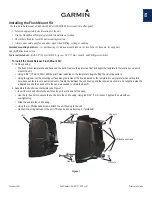
8120
Installation and Operation Manual
34
CAUTION
!
!
CAUTION
DANGER
WARNING
Bottom types
Mud, weed and sandy bottoms tend to
weaken and scatter the sonar pulse, resulting
in a weak echo. Hard, rocky or coral bottoms
reflect the pulse, resulting in a strong echo.
Frequency and cone width
Water
Cone width
Cone width
Depth
at 50 kHz
at 200 kHz
25
20
5
50
40
10
100
80
20
150
130
30
200
170
40
300
250
60
400
330
80
600
500
120
800
660
150
1000
830
190
45° cone
11°
cone
Strength of echoes
The colours indicate differences in the
strength of the echo. The strength varies with
several factors, such as the:
• Size of the fish, school of fish or other
object.
• Depth of the fish or object.
• Location of the fish or object. (The area
covered by the ultrasonic pulse is a rough
cone shape and the echoes are strongest
in the middle.)
• Clarity of water. Particles or air in the water
reduce the strength of the echo.
• Composition or density of the object or
bottom.
Planing hulls at speed produce air bubbles
and turbulent water that bombard the
transducer. The resulting ultrasonic noise
may be picked up by the transducer and
obscure the real echoes.

































